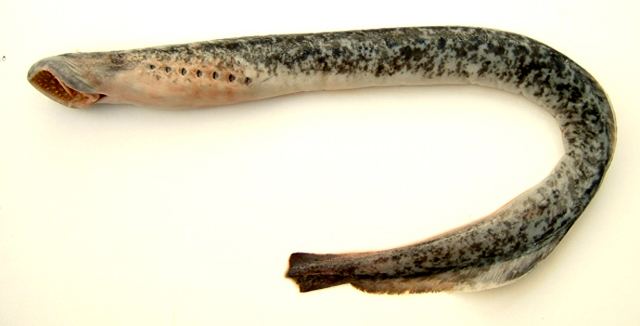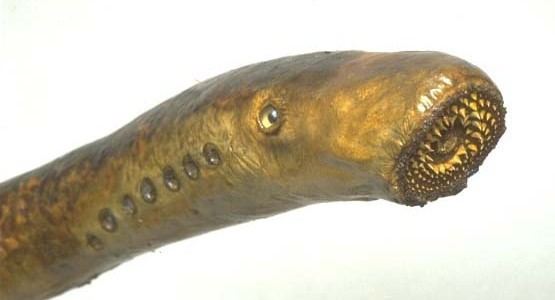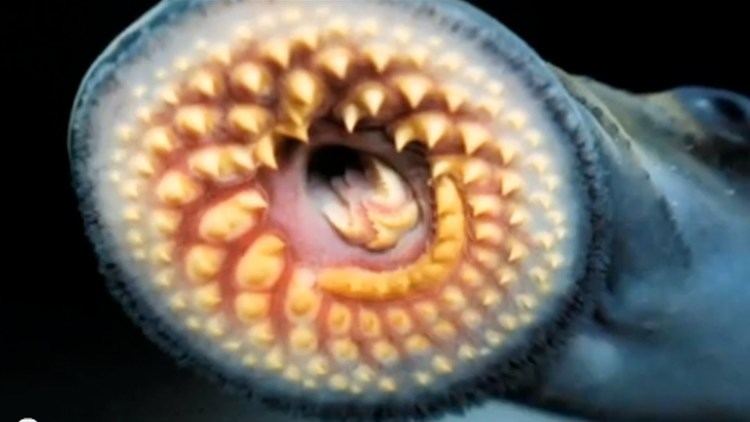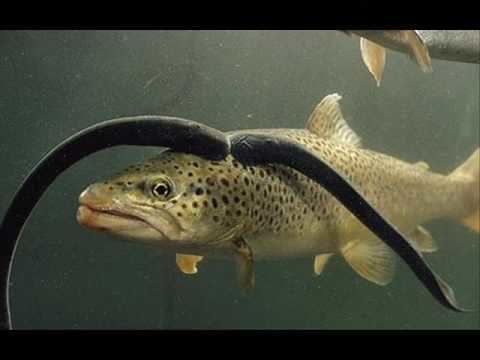Order Petromyzontiformes Scientific name Petromyzon marinus Higher classification Petromyzon | Phylum Chordata Family Petromyzontidae Rank Species | |
 | ||
Genus PetromyzonLinnaeus, 1758 Similar Lamprey, European river lamprey, Brook lamprey, Lampetra, Petromyzon | ||
silent invaders sea lamprey 2013
The sea lamprey (Petromyzon marinus) is a parasitic lamprey native to the Northern Hemisphere.
Contents
- silent invaders sea lamprey 2013
- Sea lamprey panic response
- Description
- Distribution and habitat
- Ecology
- Physiology
- Genetics
- Invasive species
- Efforts at control
- References
Sea lamprey panic response
Description
The sea lamprey has an eel-like body without paired fins. Its mouth is jawless, round and sucker-like, and as wide or wider than the head; sharp teeth are arranged in many consecutive circular rows. There are 7 branchial openings behind the eye. They are olive or brown-yellow on the dorsal and lateral part of the body, with some black marblings, with lighter coloration on the belly. Adults can reach a length of up to 120 cm (47 in) and a body weight up to 2.3 kg (5.1 lb).
Distribution and habitat
The species is found in the northern and western Atlantic Ocean along the shores of Europe and North America, in the western Mediterranean Sea, the Black Sea, and in the shores of the Great Lakes. They have been found at depths to 4000 m and tolerate temperatures between 1.0 and 20 °C. The largest European populations of sea lampreys are located throughout the south-western areas of Europe (north-central Portugal, north-northwest of Spain, and west–south-west of France). These countries also support the main fisheries of the species.
Ecology

All lampreys are anadromous. From their lake or sea habitats, they migrate up rivers to spawn (followed by the death of the spawning adults); females deposit a large number of eggs in nests made by males in the substrate of streams with moderately strong current. Larvae burrow in sand and silt bottom in quiet water downstream from spawning areas and filter-feed on plankton and detritus.

After several years in freshwater habitats, the larvae undergo a metamorphosis that allows young post metamorphic lampreys to migrate to the sea or lakes and start the hematophagous feeding. Some individuals can start the hematophagous feeding in the river before migrating to the sea, where sea lampreys prey on a wide variety of fish.

The lamprey uses its suction cup-like mouth to attach itself to the skin of a fish and rasps away tissue with its sharp, probing tongue and keratinized teeth. Secretions in the lamprey's mouth prevent the victim's blood from clotting. Victims typically die from excessive blood loss or infection. After one year of hematophagous feeding, lampreys return to the river to spawn and die, a year and a half after the completion of metamorphosis.

Lampreys are considered a delicacy in some parts of Europe, including south-western France, but are not commonly eaten in the Americas.
Physiology
Due to its lifecycle that switches between fresh and salt water, the sea lamprey is adapted to tolerate a wide range of salinities. Cell membranes on the surface of the gills are major contributors to ionoregulation. Changes in membrane composition influence the movement of different ions across the membrane, changing amounts of components to change the membranes' "environment". As the larvae (called ammocoetes) move towards the oceans, the ratio between saturated fatty acids (SFA) and polyunsaturated fatty acids (PUFA) in the gills shifts towards higher amounts of SFA, as they affect the fluidity of the membrane, and higher levels of SFA lead to a decrease in permeability compared to PUFA. Lamprey ammocoetes have a relatively narrow range of salinity tolerance, but become better able to withstand wider ranges of salinity concentrations as they reach later stages of life. Tight regulation of Na/K-ATPase and an overall decrease in expression of H-ATPase assists in the regulation the lamprey's internal fluid and ion balance as it moves to areas of higher salinity.

Lampreys also maintain acid-base homeostasis. When introduced to higher levels of acids, they are able to excrete excess acids at higher rates than most other saltwater fishes, and in much shorter times, with the majority of the transfer of ions occurring at the gill surface.
Sea lampreys parasitize other fishes for their diet, including elasmobranchs such as sharks and rays which have naturally high levels of urea in their blood. Urea is toxic to most fishes in high concentrations, and it usually excreted immediately. Lampreys are able to tolerate much higher concentrations than most other fish and excrete it at extremely high rates, obtained from ingested blood. Trimethylamine oxides present in ingested elasmobranch blood aid in counteracting the detrimental effects of high urea concentration in the lamprey's bloodstream as it feeds.
Genetics
The genome of Petromyzon marinus was sequenced in 2013. This sequencing effort revealed that the lamprey has unusual GC-content and amino acid usage patterns compared to other vertebrates. The full sequence and annotation of the lamprey genome is available on the Ensembl genome browser.
The lamprey genome may serve as a model for developmental biology and evolution studies involving transposition of repetitive sequences. The lamprey genome undergoes drastic rearrangements during early embryogenesis in which about 20% of the germline DNA from somatic tissues is shed. The genome is highly repetitive. About 35% of the current genome assembly is composed of repetitive elements with high sequence identity.
Invasive species
Sea lampreys are considered a pest in the Great Lakes region. The species is native to the inland Finger Lakes and Lake Champlain in New York and Vermont. Whether it is native to Lake Ontario, where it was first noticed in the 1830s, or whether it was introduced through the Erie Canal which opened in 1825 is not clear. Improvements to the Welland Canal in 1919 are thought to have allowed its spread from Lake Ontario to Lake Erie, and while it was never abundant in either lake, it soon spread to Lake Michigan, Lake Huron, and Lake Superior, where it decimated indigenous fish populations in the 1930s and 1940s. They have created a problem with their aggressive parasitism on key predator species and game fish, such as lake trout, lake whitefish, chub, and lake herring. Elimination of these predators allowed the alewife, another invasive species, to explode in population, having adverse effects on many native fish species. The lake trout plays a vital role in the Lake Superior ecosystem. The lake trout is considered an apex predator, which means that it has no predators. The sea lamprey is an aggressive predator by nature, which gives it a competitive advantage in a lake system where it has no predators and its prey lacks defenses against it. The sea lamprey played a large role in the destruction of the Lake Superior lake trout population. Lamprey introduction along with poor, unsustainable fishing practices caused the lake trout populations to decline drastically. The relationship between predators and prey in the Great Lakes' ecosystem then became unbalanced.
Efforts at control
Control efforts, including electric current and chemical lampricides have met with varied success. The control programs are carried out under the Great Lakes Fishery Commission, a joint Canada–U.S. body, specifically by the agents of the Fisheries and Oceans Canada and the United States Fish and Wildlife Service.
Genetic researchers have mapped the sea lamprey's genome in the hope of finding out more about evolution; scientists trying to eliminate the Great Lakes problem are coordinating with these genetic scientists, hoping to find out more about its immune system and fitting it into its place in the phylogenetic tree.
Researchers from Michigan State University have teamed up with others from the Universities of Minnesota, Guelph, and Wisconsin, and others in a research effort into newly synthesized pheromones. These are believed to have independent influences on the sea lamprey behavior. One group of pheromones serves a migratory function in that when they are made by larvae, they are thought to lure maturing adults into streams with suitable spawning habitat. Sex pheromones emitted from males are capable of luring females long distances to specific locations. These pheromones are both several different compounds thought to elicit different behaviors that collectively influence the lampreys to exhibit migratory or spawning behaviors. Scientists are trying to characterize the function of each pheromone, and each part of the molecules, to determine if they can be used in a targeted effort at environmentally friendly lamprey control. However, as of 2017, the most effective control measures still involve the somewhat unacceptable application of (3-trifluoromethyl-4-nitrophenol), or TFM, a fish poison, into rivers.
Another technique used in the prevention of lamprey population growth is the use of barriers in major reproduction streams of high value to the lamprey. The purpose of the barriers is to block their upstream migration to reduce reproduction. The issue with these barriers is that other aquatic species are also inhibited by this barrier. Fish that use tributaries are impeded from traveling upstream to spawn. To account for this, barriers have been altered and designed to allow the passage of most fish species, but still impede others.
